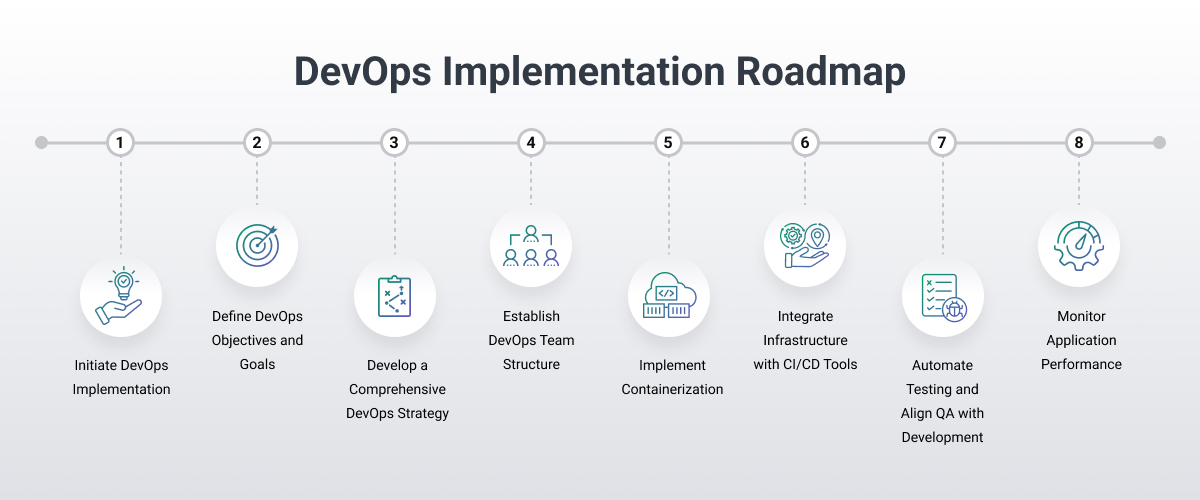Implementing DevOps practices can lead to reduced time-to-market, improved deployment frequency, and lower failure rates of new releases. By fostering a culture of collaboration and automation, organizations can achieve faster delivery of features and updates.
While the advantages of DevOps are clear, navigating the path to its successful implementation poses its own set of challenges. From laying down an effective implementation roadmap to understanding the intricate steps for a seamless transition, there's a lot to consider.
Our goal is to guide you through these complexities, offering the support and knowledge you need to unlock the full potential of DevOps within your organization.
What is DevOps and Why is it Important?
DevOps is a set of practices that combines software development (Dev) and IT operations (Ops) to shorten the system development life cycle and provide continuous delivery of high-quality software. The importance of DevOps lies in its ability to increase an organization's ability to deliver applications and services at higher speeds. By fostering collaboration between teams, DevOps helps improve efficiency and productivity.
.jpg)
Understanding the Basics of DevOps
Understanding the basics of DevOps is crucial for organizations looking to streamline their development and operations processes. DevOps involves a cultural shift that promotes collaboration, communication, and integration between development and IT operations teams. By breaking down silos and facilitating cross-functional teams, DevOps aims to improve agility and efficiency in delivering software.
Key components of DevOps include automation, continuous integration, continuous delivery, and monitoring, all of which contribute to faster and more reliable software releases. By adopting DevOps practices, organizations can respond to market changes more effectively and deliver value to customers at a rapid pace.
Why is DevOps Implementation Important?
DevOps implementation is crucial for fostering a culture of collaboration and team alignment within the organization. Successful DevOps practices involve continuous monitoring, feedback loops, and regular improvements to processes and tools. Implementing DevOps automation tools like Ansible and Docker simplifies repetitive tasks and ensures consistency in deployment.

Benefits of DevOps Implementation
Implementing DevOps brings various benefits to organizations, including:
- Improved collaboration
- Faster time-to-market
- Higher-quality software delivery
- Reduced manual errors
- Enhanced reliability of software deployments
- More stable and resilient applications
- Better customer or user experience
Additionally, implementing DevOps practices can enhance employee satisfaction, as it allows for more autonomy, creativity, and learning opportunities within teams. Many companies outsource DevOps to drive continuous improvement and be competitive in today's dynamic market landscape without needing to hire an internal team.
What are the Key Steps in a DevOps Implementation Plan?
Developing a DevOps strategy tailored to your organization's needs is the first step in the implementation process. Understanding the DevOps process involves breaking down silos between development and operations, leading to faster and more efficient service deployment.
Implementing DevOps in service deployment requires a holistic approach that incorporates infrastructure as code, version control, and automated testing. It is essential to define clear roles and responsibilities within the DevOps team to ensure streamlined operations.
Creating a DevOps Implementation Strategy
Developing a comprehensive DevOps implementation strategy is essential for organizations seeking to embrace DevOps practices effectively. A well-defined strategy outlines the steps, tools, and cultural changes necessary to transition towards a DevOps model successfully.
When creating a DevOps implementation strategy, organizations should focus on developing a roadmap that aligns with their business objectives and technological capabilities. Choosing the right DevOps tools that support automation, monitoring, and collaboration is crucial for streamlining workflows and enhancing productivity.

Choosing the Right DevOps Tools for Your Organization
Selecting the best DevOps tools for your team is crucial for enabling automation, collaboration, and efficiency. Organizations should evaluate various tools based on their compatibility with existing systems, scalability, and ease of integration to streamline the DevOps process.
Popular DevOps tools include Jenkins, Docker, Kubernetes, and Ansible, which facilitate continuous integration, containerization, orchestration, and configuration management. By selecting tools that align with the organization's technology stack and objectives, teams can optimize their DevOps practices and enhance software delivery pipelines.
Integrating DevOps tools seamlessly into the workflow enables teams to automate repetitive tasks, monitor system performance, and accelerate the deployment of software updates. By investing in the right tools, organizations can enhance their DevOps capabilities and drive innovation in software development.

Developing a DevOps Implementation Roadmap
Developing a DevOps implementation roadmap is a critical step toward ensuring the successful adoption of DevOps practices within an organization. The roadmap should outline clear objectives, milestones, and timelines for implementing DevOps processes and tools.
Identifying key stakeholders and obtaining their buy-in is essential for driving the DevOps initiative forward. Organizations should also assess their current infrastructure and technology stack to identify areas that require improvement or automation to support DevOps practices effectively.
By aligning the DevOps implementation roadmap with business goals and technological constraints, organizations can create a structured approach to implementing DevOps and realizing its benefits across development and operations teams.

Step-by-Step Guide to Implementing DevOps
Implementing DevOps requires a systematic approach that involves defining clear objectives, establishing team structures, and integrating automation tools for continuous integration and deployment. By following a step-by-step guide, organizations can streamline their DevOps initiatives and achieve sustainable growth.
1. Initiate the DevOps Initiative
The journey begins with top-level endorsement, where a CIO or IT director plays a pivotal role in launching the DevOps initiative. This step involves aligning the initiative with the company's broader IT and business goals, securing necessary investments, and assigning a program manager to oversee strategy development and execution.
2. Define DevOps Objectives and Goals
Defining clear objectives and goals is paramount to the successful implementation of DevOps within an organization. By setting specific targets related to software delivery, quality, and operational efficiency, teams can align their efforts toward achieving tangible outcomes.
Establishing measurable KPIs helps track progress, identify bottlenecks, and drive continuous improvement in DevOps practices. By defining clear goals, organizations can ensure that their DevOps initiatives are focused, impactful, and aligned with business objectives.
3. Develop a Comprehensive DevOps Strategy:
A robust strategy is central to a successful DevOps transformation. This involves setting a shared vision that encourages collaboration across development, operations, testing, and other departments. The strategy should focus on accelerating the software development cycle while maintaining high quality, integrating Infrastructure as Code (IaC) for efficient infrastructure provisioning, and automating processes from build to deployment.
4. Establish DevOps Team Structure
DevOps teams typically comprise individuals with diverse skills, including developers, operations engineers, DevOps engineers (sometimes known as cloud, platform, or site reliability engineers), and quality assurance specialists, who work together towards common goals.
Establishing clear roles and responsibilities within the DevOps team promotes accountability and transparency, enabling team members to understand their contributions to the overall success of the organization. By creating a supportive and collaborative team environment, organizations can drive sustainable growth and innovation through DevOps practices.
5. Implement Containerization
Containerizing your applications with tools like Docker enhances software reliability and independence from the infrastructure, facilitating easy and consistent deployment across different environments. This step also simplifies operations management by isolating changes to specific microservices within containers.
6. Integrate Infrastructure With CI/CD Tools
Proper management of containerized applications is achieved by integrating infrastructure automation tools (e.g., Kubernetes, Ansible, Chef) with CI/CD tools (e.g., Jenkins, Bamboo, GoCD). This combination ensures efficient configuration management, fault tolerance, continuous monitoring, and streamlined software updates and deployments.
7. Automate Testing and Align QA with Development:
While not all testing can or should be automated, identifying the right balance is key. Automate where it makes sense to speed up delivery cycles and improve test coverage. Simultaneously, ensure close alignment between QA and development teams to facilitate early detection and resolution of issues, thereby enhancing software stability and quality.
8. Monitor Application Performance
Continuous monitoring of application performance is vital to identify, prioritize, and address defects. Implement application performance monitoring tools to gain insights into software behavior, user experience issues, and system bottlenecks, enabling timely troubleshooting and optimizations.

Best Practices for Successful DevOps Implementation
Alignment between Development and Operations
Fostering Team Collaboration: The cornerstone of DevOps success lies in breaking down silos between development and operations teams. This alignment is pivotal for seamless software delivery, encouraging shared responsibilities, and ensuring both teams work towards unified objectives. By promoting open communication and knowledge sharing, organizations can significantly improve the efficiency of their software development lifecycle, enabling quicker feature delivery and fostering a culture of continuous feedback and improvement.
Strategic Adoption of DevOps Practices
Utilizing DevOps approaches tailored to your organizational context is essential. These strategies should prioritize automation, continuous integration and delivery (CI/CD), and a steadfast commitment to adopting best practices in integration, delivery speed, reliability, scalability, and security. By including monitoring policies and clear role definitions within the DevOps framework, teams can enhance their workflow efficiency and adaptability, paving the way for innovation and excellence in software delivery.
Embracing a DevOps Culture
The transition to DevOps is as much about cultural change as it is about technical processes. Adopting a DevOps culture means embracing principles of collaboration, transparency, and continuous learning. It's about building an environment where teams are encouraged to experiment, learn from failures, and continuously seek ways to improve. Investing in training, tools, and practices that support this culture is crucial for sustaining long-term success in your DevOps journey.
Investing in Continuous Learning
A successful DevOps implementation relies heavily on the team's understanding and expertise in DevOps principles and tools. Educating the team not only involves formal training and workshops but also promotes a culture of continuous learning and curiosity. It's about empowering every team member with the knowledge and skills needed to contribute effectively to DevOps practices. This includes cross-training to understand the roles and challenges of both development and operations, as well as staying updated on the latest DevOps trends, tools, and methodologies. An educated and empowered team is more agile, collaborative, and innovative, making it a critical factor in the success of DevOps within any organization.
Prioritizing Automation and Integration
Automating for Efficiency and Reliability: Automation of repetitive tasks, especially in testing, deployment, and monitoring, is a key driver of DevOps efficiency. Integrating automation tools within the CI/CD pipeline not only speeds up the development cycle but also ensures consistency and quality in software delivery. By automating processes, teams can focus on innovation and tackling complex challenges, rather than being bogged down by routine tasks.
Monitoring, Feedback, and Adaptation
Leveraging Insights for Continuous Improvement: Implementing robust monitoring and feedback mechanisms is critical for identifying areas for improvement and responding swiftly to any issues. Application performance monitoring (APM) and user feedback provide valuable insights that can guide enhancements in software functionality, usability, and performance. This continuous loop of monitoring, feedback, and adaptation is essential for refining DevOps practices and achieving optimal outcomes.
Examples of Successful DevOps Implementation
Our DevOps Case Studies
Softjourn's DevOps Team Saved Our Client Over $25k a Year on AWS
With the help of Softjourn's skilled DevOps team, our expense management client was able to save over $25,000 just this year and will continue to save thousands of dollars over time. We were pleased to reduce the cost of AWS for our client, without compromising the security or efficiency of their systems.

We Helped Cinewav Reduce AWS Costs by 30% on Their Multi-Regional Cloud Servers
Softjourn's cloud consulting services successfully addressed the challenges faced by Cinewav, resulting in an optimized, scalable, and cost-efficient cloud infrastructure. By implementing multi-regional deployment, CDN optimization, server upscaling, and efficient resource utilization, we significantly improved performance, reduced costs, and enhanced the security of Cinewav's cloud-based platform.

We Helped Bullet Seamlessly Migrate to AWS Infrastructure
When Bullet decided to become a Central Bank Regulated entity they realized it would require migrating to an infrastructure platform. Our DevOps team recommended they migrate to AWS - Softjourn built the architecture, managed the transition, and provided all the necessary support along the way.
.jpg)
The Future of DevOps: Emerging Tech & Trends
The progression of DevOps is steering towards deeper integration within software development and operations, emphasizing streamlined processes and enhanced team collaboration.
Streamlining DevOps with ML/AI
The trajectory of DevOps is increasingly influenced by emerging technologies, driving significant improvements in software development and delivery. Innovations such as artificial intelligence (AI), machine learning (ML), and serverless computing are reshaping the landscape, offering new opportunities for process automation, resource optimization, and faster delivery. AI in DevOps enables organizations to enhance efficiency, agility, and responsiveness to market changes, ensuring they remain competitive and adaptable.
DevSecOps Ensures Secure and Robust Apps
Key to this evolution is the adoption of security and compliance measures early in the development process, aligning with the DevSecOps movement to ensure robust, secure applications. The incorporation of cloud technologies, microservices, and containerization further supports building flexible and scalable solutions, marking a significant shift towards more dynamic, secure, and efficient software development paradigms.
FinOps for Cloud Cost Optimization
Integrating FinOps into the DevOps framework marks a strategic move towards optimizing cloud expenditures and enhancing financial accountability in cloud investments. FinOps, or Cloud Financial Management, involves a set of practices aimed at bringing financial transparency to the cloud spending model, enabling teams to make more informed decisions regarding resource allocation and usage.
By aligning technical and financial objectives, organizations can maximize the value of their cloud investments, ensuring that every dollar spent contributes to achieving business goals and driving innovation. Incorporating FinOps Consulting into DevOps practices not only streamlines operations but also ensures that projects remain on budget, enhancing overall operational efficiency and financial health.

How to Start Your DevOps Journey
Embarking on your DevOps journey is a strategic move toward enhancing your organization's operational efficiency and innovation capabilities. The foundation of this transformative journey is a well-defined DevOps roadmap, meticulously crafted to navigate the complexities of integration and streamline your development and operations processes.
At Softjourn, our DevOps consulting services and DevOps implementation services are tailored to guide you through each step of this journey. Our expertise in leveraging cutting-edge tools, coupled with our deep understanding of DevOps culture, positions us uniquely to facilitate your transition.
Let Softjourn be your partner in implementing DevOps, enabling your organization to unlock its full potential for continuous improvement and competitive advantage. Contact us to get started with your DevOps implementation or expansion.
FAQ
Q: What can I expect from DevOps?
A: You can expect improved collaboration between development and operations teams, faster deployment of software, increased frequency of releases, and overall more reliable and secure services.
Q: What is a DevOps model?
A: A DevOps model is a set of practices and cultural philosophies that aim to bring development and operations teams together to improve the software development process and delivery of services.
Q: What are the strategies for implementing DevOps?
A: Strategies for implementing DevOps include creating a cross-functional team, defining clear goals, automating processes, monitoring performance, and continuously evaluating and improving the workflow.
Q: How do I implement DevOps from scratch?
A: To implement DevOps from scratch, start by assessing your current processes, identifying bottlenecks, establishing a DevOps culture, automating repetitive tasks, and integrating tools for continuous integration and delivery.
Q: What services are involved in DevOps implementation?
A: DevOps implementation services typically include consulting, training, tool selection and integration, infrastructure setup, continuous integration and delivery implementation, and ongoing support and monitoring.
Q: How does DevOps benefit a business or tech platform?
A: DevOps benefits a tech platform by enabling faster delivery of new features, improved collaboration between teams, increased scalability and reliability, and better alignment with business objectives.
Q: What can I expect from implementing DevOps in a software development project?
A: Implementing DevOps in a software development project can lead to shorter development cycles, more stable operating environments, higher quality software, and improved customer satisfaction.














